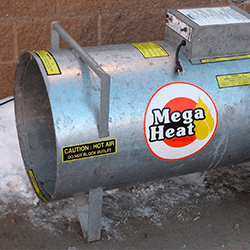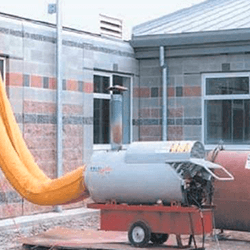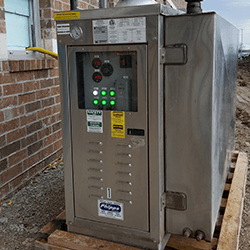Phipps Winter Heating Solutions
Posted by Matt Milos on Oct 18th 2016
Construction always presents challenges to owners, the design community, and contractors. Phipps is committed to offer innovative solutions to those challenges. Keeping projects on schedule and budget is especially difficult during the winter because excess moisture accompanies warm air that is blown into a building.
For many years direct and indirect fired heat have been the primary solutions for allowing work in cold temperatures.
Direct fired heaters add considerable moisture and carbon monoxide. Indirect units require extensive ductwork outside the building and an array of fans inside the building to move the warm air within the site. Indirect units also have high fuel costs because they must heat outside ambient air to the required temperature.
Phipps now rents in all of its locations highly safe and efficient hydronic heating systems that provide consistent, dry heat to keep your project dryer, on budget, and on track. With a hydronic system, an external burner flash heats and pumps at low pressure food grade glycol to thermostatically controlled and quiet heat exchangers placed strategically in the building. Operating much like a residential furnace, the hydronic system maintains the air temperature within the structure while only re-heating the glycol temperature differential. Consequently the hydronic system burner only operates a fraction of the time saving precious fueling dollars. Please contact us if you would like more information on how Phipps can help your winter projects be completed successfully.
Direct Fired

- Pros:
- Relatively portable
- Readily available
- Low cost
- Proven, been used for years
- The most common method in the industry
- Cons:
- Carbon monoxide emissions in work area
- Carbonization potential for slabs
- Must run 100% of the time to generate heat
- Proven, been used for years
- Puts excess moisture into structure
Indirect Fired

- Pros:
- Less fumes in work area
- Dryer air than direct fire units
- Less Equipment needed in work space
- Cons:
- Must operate 100% of the time to generate heat
- More difficult set up and ducting required
- Air only enters in one location so fans must be used to distribute heat
- Air is warm from ambient temperature
Hydronic Heat

- Pros:
- Production schedule control
- Fume free work areas
- Even/dry air – 5-7% relative humidity
- Tremendous fuel savings
- Quiet operation
- Low power consumption
- Flexible set up, operation and fueling options
- Unit typically only operates a tenth of the time of traditional methods
- Cons:
- Higher initial rental cost that leads to overall savings generated by less fuel consumption
- Hoses require some management to keep an organized jobsite

